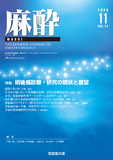Japanese
English
- 有料閲覧
- Abstract 文献概要
- 1ページ目 Look Inside
- 参考文献 Reference
はじめに
1990年代以降,いくつかの研究で術後疼痛管理サービス(acute pain service:APS)チームの介入が術後痛を低減させ,手術患者の合併症予防や在院日数を減少させることが報告されたことにより,欧米諸国においてAPSチームが広く普及することとなった。しかし,その一方で,わが国においては長らくAPSの普及が進まず,この領域において日本は後進国であった。しかし,2022年の診療報酬改定において,APSチームの活動に対して診療報酬加算の算定が可能となったことで,わが国においてもAPSを導入する施設が増加しつつある。わが国においても普及しつつあるAPSであるが,APS導入の妨げとなる要因やAPS活動におけるトラブルなど,それぞれの施設ごとにAPSのさらなる普及に対してさまざまな障壁が存在している。本論文では,わが国におけるAPSの現状を確認し,その問題点を共有することで,さらなるAPSの発展に向けて取り組むべき点を明らかにしたい。
Since the 1990 s, several research groups have reported that the application of acute pain service(APS)in the postoperative management of patients’ pain reduces the severity of postoperative pain, helps prevent complications in surgical patients, and shortens hospital stays. As a result, APS has become widely implemented in many countries. The adoption of APS in Japan had long remained limited, lagging behind in this field. However, with the 2022 revision of Japan’s national health insurance reimbursement system, APS team activities became eligible for additional medical reimbursement, leading to a gradual increase in the number of institutions in Japan introducing APS. Although APS is becoming more widespread in Japan, various barriers to further dissemination remain, including factors that hinder the implementation of APS and clinical issues that are encountered in daily practice, which differ among institutions. This article reviews the current status of APS in Japan, describes the challenges to its implementation, and identifies key areas for improvement to promote the further development of APS.

Copyright © 2025 KOKUSEIDO CO., LTD. All Rights Reserved.


